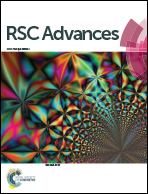One dimensional CdS nanostructures: heterogeneous catalyst for synthesis of aryl-3,3′-bis(indol-3-yl)methanes†
Abstract
Herein, we have developed a novel heterogeneous catalytic system for synthesis of bis(indol-3-yl)methanes using one dimensional (1D) CdS nanorods. CdS nanorods were synthesized by a solvothermal reaction technique at 200 °C over 12 h in the presence of ethylenediamine as a solvent. The prepared 1D CdS was characterized using various spectroscopic methods. X-ray diffraction (XRD) revealed the formation of highly crystalline CdS having a wurtzite structure. FESEM analysis confirms the formation of a rod like morphology with length around 150 to 200 nm and diameter ∼15 nm. TEM also validates the formation of uniform size one dimensional (1D) CdS nanostructures. The catalytic activity of 1D CdS as a Lewis acid was investigated for the synthesis of bis(indol-3-yl)methanes (BIMs) with various substituted aldehydes and indoles within shorter reaction time affording the corresponding product in excellent yield.


 Please wait while we load your content...
Please wait while we load your content...